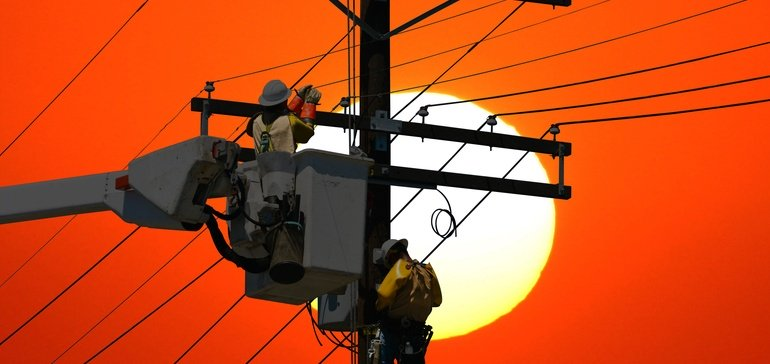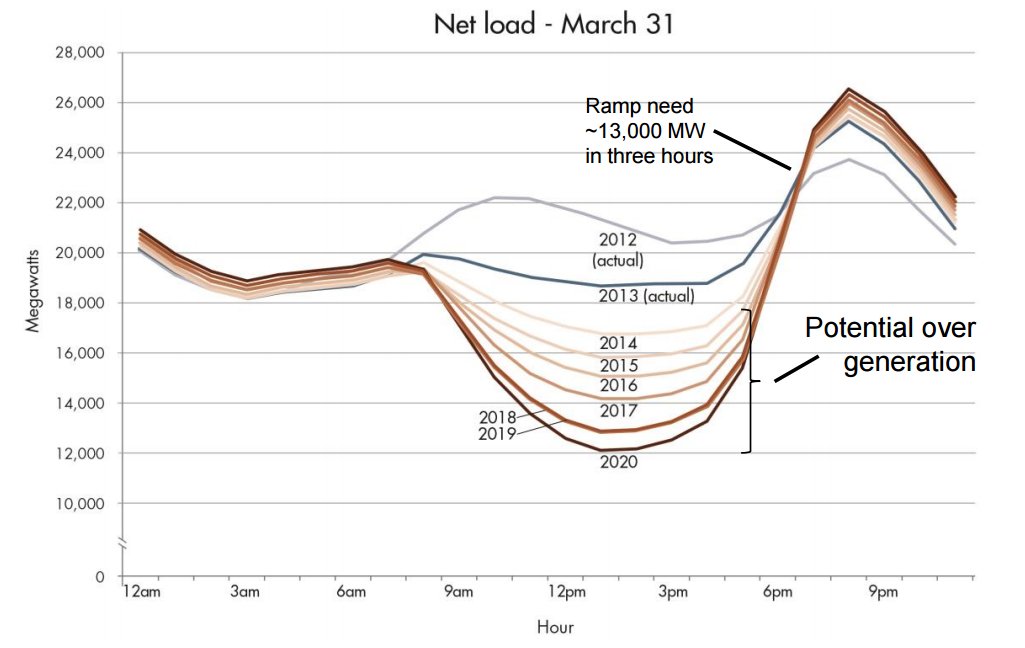California had rolling blackouts https://www.utilitydive.com/news/california-power-outages-underscore-challenge-of-maintaining-reliability-du/583727/ because of airconditioner demand soarding in a heat wave while some gas plants went offline.
With enough electric vehicles using their batteries smartly this would NEVER happen. Not even with 100% solar and wind. (thread)
With enough electric vehicles using their batteries smartly this would NEVER happen. Not even with 100% solar and wind. (thread)
Developing such scenarios is my work: I research and develop energy transition models at the @TUeindhoven where I am also program director of http://NEONresearch.nl and I have a small consultancy company translating scientific knowledge into practice at http://zenmo.com .
First let's look at the electricity flows.
The problem is the ramp up and the peak on hot days when solar is gone but air conditioners are still running.
Ideally you would have 13 gigawatt of excess power that you could quickly add to your portfolio.
The problem is the ramp up and the peak on hot days when solar is gone but air conditioners are still running.
Ideally you would have 13 gigawatt of excess power that you could quickly add to your portfolio.
Now let's look at the potential of electric vehicles (EVs).
I think EVs are the future because of simple economics: they use around 4x less energy (yes. really.) and can run directly on solar and wind, that are becoming increasingly cheap and abundant.
I think EVs are the future because of simple economics: they use around 4x less energy (yes. really.) and can run directly on solar and wind, that are becoming increasingly cheap and abundant.
With falling battery prices they will soon have a much lower total cost of ownership (depending on your situation this could already be the case) and before 2030 they will also be easier to buy in the showroom.
Thus I've been writing for over a decade that they are the future.
Thus I've been writing for over a decade that they are the future.
There are currently 15 million cars in California. Let's for the sake of example imagine they all become electric.
Let's further assume they all use a a modest household socket with max 2 kilowatt of power. (In Europe it's mostly 230V three phase or around 12 kilowatt.)
Let's further assume they all use a a modest household socket with max 2 kilowatt of power. (In Europe it's mostly 230V three phase or around 12 kilowatt.)
One of the quick win for competent legislators and entrepreneurs is 'smart charging' these electric vehicles (EVs).
That means charging them when there is enough supply, ideally from solar & wind.
The impact of EVs is staggering and I don't hear people talking about it enough.
That means charging them when there is enough supply, ideally from solar & wind.
The impact of EVs is staggering and I don't hear people talking about it enough.
IF such a system was implemented that would give California a flexible demand of 15 million cars x 2 kilowatt per car.
That's a whopping *30* gigawatt of flexible demand!
That's twice the amount of power you need in total, even if all other generation was inflexible.
That's a whopping *30* gigawatt of flexible demand!
That's twice the amount of power you need in total, even if all other generation was inflexible.
Unfortunately, not every vehicle would charge every day so not all of that load can be played with. But it gets better!
Car batteries are increasingly lasting much longer than the electric vehicle and that means there is no harm in using them to *discharge* and then recharge.
Car batteries are increasingly lasting much longer than the electric vehicle and that means there is no harm in using them to *discharge* and then recharge.
We call this V2G (for vehicle to grid) or sometimes bidirectional charging. If cars would do this they could actually influence demand and supply *both ways*.
That means the grid operator would be able to have 30 gigawatt of supply and 30 gigawatt of demand at their fingertips!
That means the grid operator would be able to have 30 gigawatt of supply and 30 gigawatt of demand at their fingertips!
So that is a flexible load (either supply or demand), available within second, which is larger than the *entire* demand and supply in California.
With that kind of flexibility you can squash the most extreme duck curve into a ruler flat line without breaking a sweat.
With that kind of flexibility you can squash the most extreme duck curve into a ruler flat line without breaking a sweat.
But electric vehicles can only do this for a couple of minutes, right? Wrong!
Now I must switch my explanation from power to energy. Put simply:
- POWER is how FAST you use electricity
- ENERGY is how MUCH you use
This confuses many people so allow me one tweet with an analogy.
Now I must switch my explanation from power to energy. Put simply:
- POWER is how FAST you use electricity
- ENERGY is how MUCH you use
This confuses many people so allow me one tweet with an analogy.
Imagine water flowing from you faucet:
POWER is how FAST it can flow out of your faucet.
That's expressed in watt.
(Here billions of watts: gigawatts.)
ENERGY is the SIZE of the lake or water tower that the water comes from.
That's expressed in wattHOUR.
(Here: gigawattHOUR.)
POWER is how FAST it can flow out of your faucet.
That's expressed in watt.
(Here billions of watts: gigawatts.)
ENERGY is the SIZE of the lake or water tower that the water comes from.
That's expressed in wattHOUR.
(Here: gigawattHOUR.)
On an average day, California uses around 700 gigawatthour.
If you have 15 million vehicles with a 50 kWh battery (the smallest Tesla battery) that gives you 750 gigawatthour.
That's enough to give California electricity for an ENTIRE DAY.
If you have 15 million vehicles with a 50 kWh battery (the smallest Tesla battery) that gives you 750 gigawatthour.
That's enough to give California electricity for an ENTIRE DAY.
In practice, you also have solar, wind and fossil fuel and you only have to cover for the imbalance. So I estimate that even on a super hot day (meaning loads of pesky air conditioners running) and 100% wind and solar, you would at most need a third of that. Probably much less.
Now I'm not saying every human being on the planet should get an electric vehicle with a big juicy battery and that would solve all our energy woes. I'm actually an ardent believer in biking, shared autonomous electric vehicles, public transportation, and less private cars.
What I am saying is this: we should make all remaining vehicles electric asap and then use their batteries smarly.
This would make implementing 100% solar and wind in California a breeze while eliminating any chance of blackouts.
/end
This would make implementing 100% solar and wind in California a breeze while eliminating any chance of blackouts.
/end
I get the question whether V2G fits into consumer behavior. We've simulated this for the Dutch, assuming travel behavior will not change.
Since cars are parked ~23 hours a day and have a battery to last 10x the average daily mileage this at most halves availability.
Since cars are parked ~23 hours a day and have a battery to last 10x the average daily mileage this at most halves availability.

 Read on Twitter
Read on Twitter



